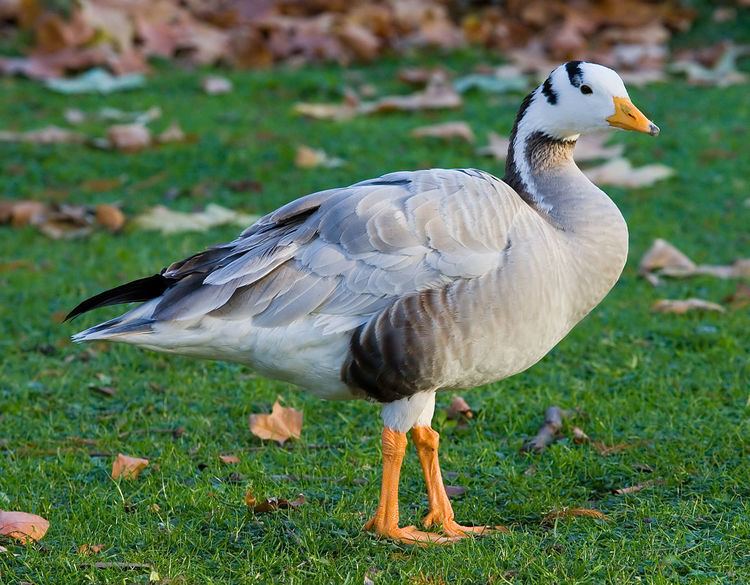 | ||
The hamsa (Sanskrit: हंस, haṃsa or hansa) is an aquatic bird of passage, such as a goose or a swan. Its icon is used in Indian and Southeast Asian culture as a spiritual symbol and a decorative element.
Contents
Identification
Monier Williams translates the term from Sanskrit as "goose, gander, swan, flamingo, or other aquatic bird of passage". The word is also used for a mythical or poetical bird with knowledge. In the Rig Veda, it is the bird which is able to separate Soma from water, when mixed; in later Indian literature, the bird separates milk from water when mixed. In Indian philosophical literature, hamsa represents the individual soul or spirit (typified by the pure sunlight-white like color of a goose or swan), or the "Universal Soul or Supreme Spirit".
The word Hamsa is cognate with Latin "(h)anser", Greek "χήν", German "Gans", English "goose", Spanish "ganso" and Russian "гусь". However, Henry Milman and others state that some early translators were misled by the closeness of the word Hamsa to Gans, and this is likely an incorrect link.
Swan or goose controversy
Jean Vogel, in 1952, questioned if hamsa is indeed swan, because according to Dutch ornithologists GC Junge and ED van Oort he consulted, swans were rare in modern India while the Indian Goose (Anser indicus) were common. According to Vogel, Western and Indian scholars may have preferred translating hamsa in Sanskrit text as swan because the indigenous goose appears plump while the swan (and, Vogel adds, the flamingo) appears more graceful.
Paul Johnsgard, in 2010, has stated that mute swan (Cygnus Olor) do migrate to northwestern Himalayan region of India every winter, migrating some 1000 miles each way. Similarly, the British ornithologist Peter Scott, in his Key to the Wildfowl of the World, states that northwestern India is one of the winter migration homes for mute swan, the others being Korea and Black Sea. Grewal, Harvey and Pfister, in 2003, identified large swaths of northwestern India and northeastern Pakistan particularly Kashmir and parts of south Pakistan as winter habitats of mute swans.
The Sanskrit and Pali languages, both have alternate words for goose such as Jalapada, Dhamara, Cakragki, Majjugamana, Shvetagaruta and others.
Dave states that the hymns of Rigveda, and verses in Hindu Epics and Puranas mention a variety of birds with the root of hamsa (हंस), such as Maha-hamsa, Raj-hamsa, Kal-hamsa and others, most of which relate to various species of swans particularly mute swan, while some refer to geese. Dave's identification is based on the details provided in the Sanskrit texts about the changes in plumage over the bird's life, described voice, migratory habits, courtship rituals and flying patterns. Some Sanskrit texts, states Dave, distinguish between Hamsa and Kadamb, the former being swan and latter as bar-headed goose.
In Hinduism
The hamsa, or the swan, is often identified with the Supreme Spirit, Ultimate Reality or Brahman in Hinduism. The flight of the hamsa symbolizes moksha, the release from the cycle of samsara.
The hamsa is also the vahana of Saraswati – the goddess of knowledge and creative arts, and her husband Brahma – the god with powers of creation, in Hindu trinity.
Lake Manasarovar in Hindu mythology, is seen as the summer abode of the hamsa. Poetical images are derived from the flight of the swans to that lake in the Himalayas.
Yoga
During pranayama, which is a yogic exercise of breath control, hamsa came to epitomize the prana, the breath of life.
Paramhamsa
In view of the association of a hamsa with several attributes as indicated above, Hindu rishi and sadhu have been given the title of paramhamsa, that is, the supreme hamsa. It connotes a particular person who has reached a high level of spirituality.
For example, Paramahamsa Upanishad calls that Yogi a Paramhamsa who is neither opinionated nor affected by defamation, nor jealous, not a show off, is humble, and is oblivious to all the human frailties. He is immune to the existence of his body, which he treats as a corpse. He is beyond false pretensions and lives realizing the Brahman. In chapter 3, the Paramhamsa Upanished states that the one who understands the difference between "staff of knowledge" and "staff of wood", is a Paramahamsa.
Mythology
Hamsa, or Hansa, are part of Indian mythology. Arayanna, or heavenly hamsa (swans), are said to live in Manasasaras in the Himalayas. They are mentioned in the Hindu Epic, the Ramayana. Hamsa, the swan, is part of the mythical love story of Nala and Damayanti, where it carries the stories, historical information and messages between the two strangers.
In Indian mythology, it is said to eat pearls and separate milk from water from a mixture of both.
Buddhism
The hamsa was also used extensively in the art of Gandhara, in conjunction with images of the Shakyamuni Buddha. It is also deemed sacred in the Buddhadharma.
Contemporary usage
The name in other languages in which it is culturally important are Hindi: hans, Burmese: ဟင်္သာ, IPA: [hɪ́ɴθà], and commonly spelt hintha or hinthar; Mon: ဟံသာ, [hɔŋsa] or hongsa; Shan: ႁင်းသႃႇ, [haŋ˦ sʰaː˨] or hong; Thai: หงส์, [hǒŋ].
The hintha (hamsa) is widely depicted in Burmese art, considered to be "swan" in its mythology, and has been adopted as the symbol of the Mon people.
